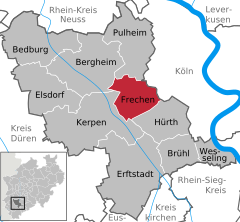|
Frechen
Frechen (German pronunciation: [ˈfʁɛçn̩]; Ripuarian: Frechem) is a town in the Rhein-Erft District, North Rhine-Westphalia, Germany. Frechen was first mentioned in 877. It is situated at the western Cologne city border. It is the site of the 1257 Battle of Frechen between Conrad von Hochstaden, Archbishop of Cologne and the people of the town. In the 16th century it became known for locally produced terra cotta products, especially the "Bartmannskrug" (beardman jug). In the late 18th century lignite was industrially mined. Digging for lignite dominated the city's economy until the end of the 20th century, and in 1891 the first briquette factory was opened. On 2 September 1951 Frechen received its city-rights including the villages of Bachem, Hücheln and Buschbell. On 1 January 1975 the nearby villages of Grefrath, Habbelrath, Königsdorf and Neufreimersdorf were also incorporated. In 1971, the Keramion, a ceramics museum in a distinctive glass-enclosed modern structure designed by architect Peter Neufert, opened to display the extensive historic and contemporary collection of local collector Gottfried Cremer. From the 1980s onwards an increasing number of industrial, commercial and service enterprises choose Frechen as their location, so that the town changed its features considerably. PopulationAs of December 31, 2021 there were 52,155 inhabitants registered. Local council
Elections were held in September 2020.
Notable people
Twin towns – sister cities
References
External linksWikimedia Commons has media related to Frechen. |
||||||||||||||||||||||||||||||||||||||||||||||||||||||||
Portal di Ensiklopedia Dunia






